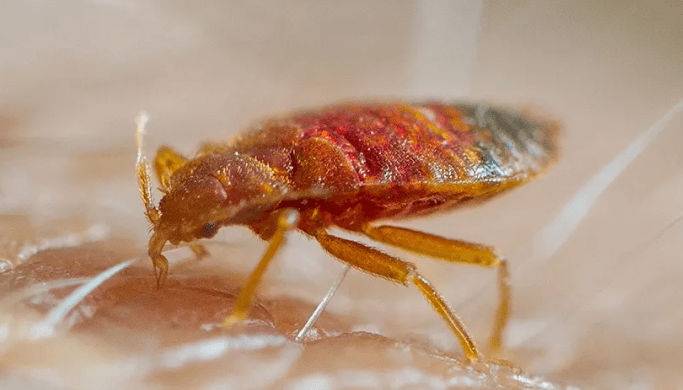The bed bug menace: why are bed bugs so difficult to deal with? by Jasmin Fox-Skelly
Insecticide-resistant bed bugs are spreading throughout the world, and infestations are garnering media attention. How should we handle them? There is now a bed bug outbreak sweeping over France.
Bed bugs have been discovered in hospitals, theaters, trains, and schools in Paris this year. However, the infestation has been accelerating for a while. A patient was brought to a French hospital in 2020 carrying bed bugs, forcing the closure of the entire unit. Four rooms were found to be contaminated, according to investigations using a sniffer dog, which led to the decision to close the unit. The treatment for the closure, which lasted 24 days, cost about US$400,000 (£333,000).
It looks to be a part of a “global resurgence” of bed bugs, which over the past two decades have become an increasing concern in cities all over the world. Bed bugs are tiny, oval-shaped insects that are smaller than a grain of rice. Global travel has made it simpler for the biting insects to proliferate since it has allowed them to hide among unaware airplane passengers’ bags and cross continents. However, a recent study indicates they might also be getting more difficult to treat once they get a foothold someplace.
As a young postdoctoral researcher in North Carolina in 2005, Warren Booth started acting in an unusual way. He got in touch with pest control businesses and asked them to send him Cimex lectularius, or common bed bugs. He was able to gather 161 instances from distinct infestations between 2005 and 2009 in 38 US states. He wanted to research them, but his work was interrupted when the University of Tulsa offered him a position as a geneticist.
He linked up with his doctoral student Cari Lewis, who had gathered a collection of 233 bed bugs from US states between 2018 and 2019, fifteen years later. They possessed a sizable stockpile when combined. How should one go, though? They started to sequence the bugs’ DNA because they were geneticists.
In a section of the genome that codes for the sodium channel, they were searching for mutations. Both bed bugs and people alike depend on this channel for proper nerve activity. Every neuron in the body has one of these embedded inside the cell membrane. Positively charged sodium atoms, or ions, can move from the outside to the inside of the neuron as it opens. As a result, the neuron “spikes,” enabling the transmission of messages throughout the body.
Although sodium channels are vital for living, some medications prevent them from functioning properly. DDT, an outlawed pesticide, and pyrethroid insecticides, a popular over-the-counter treatment for bed bugs, are examples of these. Both bind to sodium channels and prevent the closure of the channels.
According to Booth, who is currently an associate professor of urban entomology at Virginia Tech University in Blacksburg, US, “the nerve continually fires and the animal dies of paralysis.”
Bed bugs have developed three distinct mutations in the sodium channel genes throughout time, preventing pesticides from attaching to them. Although the exact timing of the mutations’ emergence is unknown, they have existed since at least the 1950s, following the extensive usage of DDT in World War Two.
It has been challenging to gauge the extent to which these alterations are present in the bed bug population up until this point.
According to Booth and Lewis’ research, 36% of the older bed bugs gathered in the US between 2005 and 2009 had just one sodium channel gene mutation, whereas 50% had two. Only 2.5 percent of the population was unmutated and therefore vulnerable to pesticides.
“Whenever you have one of the mutations it results in a several hundred-fold resistance to pyrethroid insecticides,” Booth explains. “If both mutations are present, the risk increases by around 16,000-fold. Therefore, it implies that you won’t execute them. You could cover them with a bucket’s worth of insecticides and it would still have no effect.
84% of the bed bugs in the more recent samples from 2018–2019 have two mutations in their sodium channel gene, providing them with complete resistance. In the more recent samples taken in the US, not a single bed bug was responsive to insecticides.
“We saw a change in frequency of not the single mutation – the single mutation was always present – but the change in the frequency of having both mutations, so therefore that higher level of resistance,” Booth explains. These days, these mutations are present in nearly every population of bed bugs, which is a big problem because killing them won’t work. This means that hiring a professional pest control service is much more necessary than simply buying an over-the-counter insecticide from your neighborhood hardware store.
IF AND WHEN BED BUGS BIT
The five hours between 12 a.m. and 5 a.m. during the night are when bed bugs are most active. We’re more likely to be in deep slumber and less likely to wake up and stop feeding, so it’s not an accident.
With the use of two cues—carbon dioxide (CO2) emissions and body heat—insects focus on sleeping humans. The bugs can detect CO2 from a distance of around 3 feet (0.9 m), and body heat from a little closer.
The bugs will travel several meters at night in search of a host, so you don’t have to be sleeping close to them to get bitten. The extensive use of popular over-the-counter insecticides, according to Booth and Lewis, is what caused this transformation.
“People do not want to spend thousands of dollars treating bedbugs if they think they can go down to the hardware store and buy a $5.99 (£4.90) bottle of insecticide to kill them,” Booth explains. “Unfortunately, what they are doing when they do that is selecting for bed bugs with the mutations, eliminating the ones you can kill, but allowing the ones that you can’t kill to thrive.”
In other words, bed bugs with genes that still make them vulnerable to insecticides don’t live to pass on their DNA, whereas bed bugs with resistant genes do, causing the population to grow quickly and become challenging to eradicate.
Is this the case elsewhere in the world as well? Ondrej Balvin, an ecologist at the Czech University of Life Sciences in Prague, was Booth’s collaborator in 2018. They collaborated to sequence the DNA of 393 bed bugs collected from 131 distinct infestation sites around Europe. The UK, France, Germany, Switzerland, Italy, Poland, Sweden, and other nations were among those sampled. They discovered that 93.5% of bed bugs had only one mutation and that only 3.8% of bed bugs were responsive to pyrethroid insecticides. But none had acquired two mutations, unlike the US.
It seems that a higher rate of mutation was being caused by something in US bed bug populations. It’s possible that a female bed bug having a single mutation at one time in the past unintentionally picked up a second mutation. Because it effectively rendered bed bugs resistant to over-the-counter insecticides, that variation quickly spread across the population.
A majority of bed bugs in Australia and Asia had single mutations, according to other studies. While a recent study found that mutations are now common in Iran among a different species of tropical bed insect called Cimex hemipterus.
“In Europe, Asia and Australia, we find that instead of having both of mutations, bed bugs tended to have only one of those mutations,” Booth explains. “But it’s still not good. You won’t be able to go to your local store and treat this yourself because these insects are still hundreds of times resistant to pyrethroids.
But more recently, scientists have discovered double sodium channel alterations in the populations of bed bugs in Paris. A study of 156 bed bug specimens gathered from buildings throughout the French capital in 2019 revealed that 73% of them had multiple mutations, which may be the cause of the city’s current bed bug epidemic.
But the sodium channel-related resistance is the sole topic of focus in all of these research. According to research, bed bugs are evolving resistance to additional insecticide types as well.
Adapting new behaviors
Researchers from the University of Sydney in Australia discovered evidence that bed bugs had evolved a stronger exoskeleton to prevent insecticides from being absorbed into their bodies in a 2016 study. The thickness of the bed bug’s cuticle, or outer covering, increased with the level of resistance to pyrethroid insecticides. Effective resistance to the insecticide was seen in insects with a cuticle thickness of around 10 micrometers (about one hundredth the thickness of a human hair).
Booth claims that bed bugs are altering their behavior in order to escape being poisoned.
“If you look at a bed bug they are pretty flat to the ground,” Booth explains. “However, we are seeing some now that can stand up and keep their body off the surface, allowing them to minimise the part of their body that comes into contact with the insecticide.”
Bed bugs are challenging to cure in other ways as well because of their behavior. Bed bugs frequently move from one location to another, hiding in small crevices, behind wallpaper, beneath carpets, and amid household detritus. Therefore, they might travel for extended periods of time without coming into contact with insecticide residues. This was supported by a 2020 study in which entomologists Stephen and Alice Kells subjected cockroaches and bed bugs to chlorfenapyr, a relatively new pesticide to which bed bugs are still not fully resistant.
They measured how much of the chlorfenapyr was actually absorbed into the insect bodies using two distinct products—a liquid spray and an aerosol. They discovered that for both formulations, bed bugs absorbed substantially less insecticide into their bodies than cockroaches did.
“Exposure of bed bugs to an insecticide is very much a time and dose relationship,” states Stephen Kells. “Bed bugs must come into prolonged contact with the leftovers for the dose to build up. Therefore, it’s likely that bed bugs will either avoid the exposure altogether or not be in contact enough to receive a lethal dose if they’re not sprayed in the proper places or at the right quantities.
Defending oneself against bed bugs
What steps can we take to eliminate the bed bug, if any? Heat therapy is one choice, which entails heating the space or the entire property to a high temperature. Researchers collected 5,400 adult bed bugs from 17 infected areas in Paris for a study this year. To mimic their natural surroundings, they divided them into five groups and put each group in a different tank. While some were left exposed in the open air, some were permitted to set up camp amongst furniture scraps, mattress remnants, or blanket remnants. The bugs were then heated by the researchers. After only one hour of heating to 60°C, all the bugs had died.
However, a 2021 study discovered that bed bugs typically just go when it becomes too hot. This could be an issue, especially in apartment complexes with multiple stories, where bed bugs could easily spread from one unit to an unknowing neighbor’s apartment.
You shouldn’t try to heat your house at home either.
Never attempt to use heat on your own, advises Booth. “I’ve heard tales of individuals purchasing gas heaters and subsequently igniting their home. It really isn’t effective. It’s more likely that you’ll kill yourself than the bed bugs.
To make bed bugs more vulnerable to insecticides, some researchers are devising methods to entice them out of their hiding spots. A device that can imitate human breathing was recently developed by students at Stockholm’s Royal Institute of Technology. According to study, bedbugs are drawn to the carbon dioxide (CO2) that humans emit, therefore the machine might serve as bait to entice them out of their nests.
Additionally, scientists are creating biopesticides with natural bases that are less susceptible to insect resistance development. In 2012, Beauveria bassiana, a native and natural fungus that causes sickness in insects but is safe for people, was included in a formulation created by Nina Jenkins, an entomologist at Pennsylvania State University in the US.
To make bed bugs more vulnerable to insecticides, some researchers are devising methods to entice them out of their hiding spots. A device that can imitate human breathing was recently developed by students at Stockholm’s Royal Institute of Technology. According to study, bedbugs are drawn to the carbon dioxide (CO2) that humans emit, therefore the machine might serve as bait to entice them out of their nests.
Additionally, scientists are creating biopesticides with natural bases that are less susceptible to insect resistance development. In 2012, Beauveria bassiana, a native and natural fungus that causes sickness in insects but is safe for people, was included in a formulation created by Nina Jenkins, an entomologist at Pennsylvania State University in the US. In any case, it is false to state that bed bugs may have “caught” from France to other cities in Europe and the US.
“Are bed bugs infestations suddenly erupting across France and London, or have they simply gone unreported?” Booth asks. “I believe the latter. Although they have always existed, they have mostly gone ignored. Since they are so cryptic, many infestations at low levels will go undetected.
There is hope that infections can be controlled with the correct strategies. According to a 2022 study, bed bug reports significantly decreased in New York between 2014 and 2020 after the city passed legislation requiring landlords to disclose infestations and tell all occupants of the building. Additionally, landlords must take care of infestations within 30 days. However, even in this study, the lower income boroughs of Queens and Staten Island experienced sharper reductions than the higher income boroughs of Manhattan and Brooklyn. There were persistent complaints of infestations in several low-income communities. Other US cities, like Chicago, have shown same tendencies.
“We sadly find that in low-income housing bed bugs are seen as a nuisance and simply tolerated as they cannot afford to eliminate them,” Booth explains. “These may act as reservoir populations that can act as a source for future infestations.”
It’s one thing to win a war by getting rid of bed bugs from a house or other structure. Will this ongoing nuisance ever be permanently eliminated by humanity?
“If you think you’re ever going to get rid of them the answer is no,” Booth says. “Unfortunately, bed bugs are with us until we disappear from this planet.” SOURCE: The BBC, article by Jasmin Fox-Skelly. This story was publisged by the BBC




